Seventy-eight percent of people who fall victim to online scams lose money. This is according to research firm Statista. With such a huge percentage of people losing money, it’s essential to learn how to spot scams.
Sometimes fake websites are easy to identify. Sometimes they resemble genuine sites so much that it takes a keen eye to realize they are illegitimate. So, how can you identify a genuine website?
1—Look for SSL Protection
Every safe website in 2022 is secured through Secure Socket Layer (SSL) encryption. There are two easy ways to check whether a site has SSL or not.
First, look for a locked padlock sign on its address bar. If you click on this sign, a message will usually pop up confirming that the site is secure. The second way is to look at a site’s full url address.
For example, this website’s full address is https://www.scoopbyte.com/. It starts with “https” and not “http.” The letter ‘s’ in https stands for secure. Fake websites have websites whose url addresses start with http.
To expound more, HTTPS websites keep your data safe while using a site. Think of your name, email address, home address, passwords and financial information. By comparison, HTTP sites expose your personal information to hackers.

2—Licenses and Certificates
In some industries, genuine websites need special licenses and certificates to prove they are legit. Take the banking industry as an example. Banks, digital wallets like PayPal and credit companies must comply with their regulators.
Another regulated industry is the iGaming sector. Casinos, betting websites and even fantasy sports companies need licenses from gambling regulators to set themselves apart from fraudsters.
In the US, gambling regulation is a matter of state concern. This means gambling companies can only acquire licenses in states where iGaming is legal: New Jersey, Pennsylvania, Michigan, Delaware and West Virginia, to name a few.
That said, the safest US online casinos have licenses, and certificates from independent auditors and great reputations. Good ratings are particularly important because they let you know how a site treats its customers.
In case you’re wondering, most regulated websites post their licensing and certificate information at the bottom of their sites. So, check these details before you get into a site.
3—Pay Attention to the Website Name
You want to buy the latest Air Jordan sneakers. You’ve heard you can get great discounts at Nike’s official website. The problem: you’ve never used the site in the past. To avoid getting scammed, start by verifying the name of Nike’s official site.
To be clear, you can buy Air Jordan shoes at nike.com. With this information in mind, you’ll know that any site with a slightly different name isn’t the official Nike’s site.
Sometimes scammers create websites that look like the original but they have one different letter. For example, a fake Nike shop could call itself nikke.com or nikey.net. Against that backdrop, always double check that you’re on the right website.
4—Look at the Contact Information
Another way to differentiate a fake from a safe website is through its contact information. It is in the best interest of a genuine company to publish its contact information on its website.
Think about it. If you owned an eCommerce store and you had a website, you would tell people where to locate you. You would also post your email address, phone contact and even social media details.
On the other hand, fake websites have no physical addresses. They also won’t share their phone contacts but they might publish fake contact information. Fortunately, it is easy to identify fake contact details.
Find an email address on a website and send the company a short message. If the email is delivered successfully, it’s probably genuine. If it’s not delivered, that’s fake information.
Additionally, call the number provided. If no one takes your calls, it is because the company does not want you to contact them.
5—Grammatical Mistakes
Excessively poor grammar is a sure telltale of a fake website. You see, fraudsters don’t spend a lot of time on web design and correct grammar. They put up their sites hurriedly so that they can scam and close down their platforms.
What’s more, some of these scammers are based overseas. They are not native English speakers, which is why they have websites with so many grammatical errors.
Secondly, scammers are not in the business of spreading informative content. Even if they can speak fluent English, they won’t take the time to publish original, informative and proofread content.

6—Scam Language and Content
Scammers have a way of communicating that many people fall for. They insinuate a sense of urgency when selling you their fake products. If they run an eCommerce store, they could say they have a 90% discount running for three hours.
If you need a TV and find a site with a 90% discount, you’ll probably want to buy it. If the deal is only available within three hours, you could really get tempted to make the purchase immediately.
Cyber attackers whose goal is to infiltrate your devices with malware publish clumsy content on their sites. And they post a link asking you to download something in every section.
7—Read Terms and Conditions
Every website has terms and conditions. Yet, most people don’t read these terms. And this often leads to cases of people getting scammed. This is especially true for online businesses with standard security measures.
Maybe you want to buy stocks online. You spot a website advertising its services. Upon checking the site, it has a padlock sign on its address bar. It uses correct grammar and even features testimonials.
However, you might not realize it is a scam until you read its terms and conditions. Maybe it doesn’t let you transfer your stocks. Perhaps it has high hidden fees. Or it probably shares your data with its partners, something it has stated on its terms and conditions.
